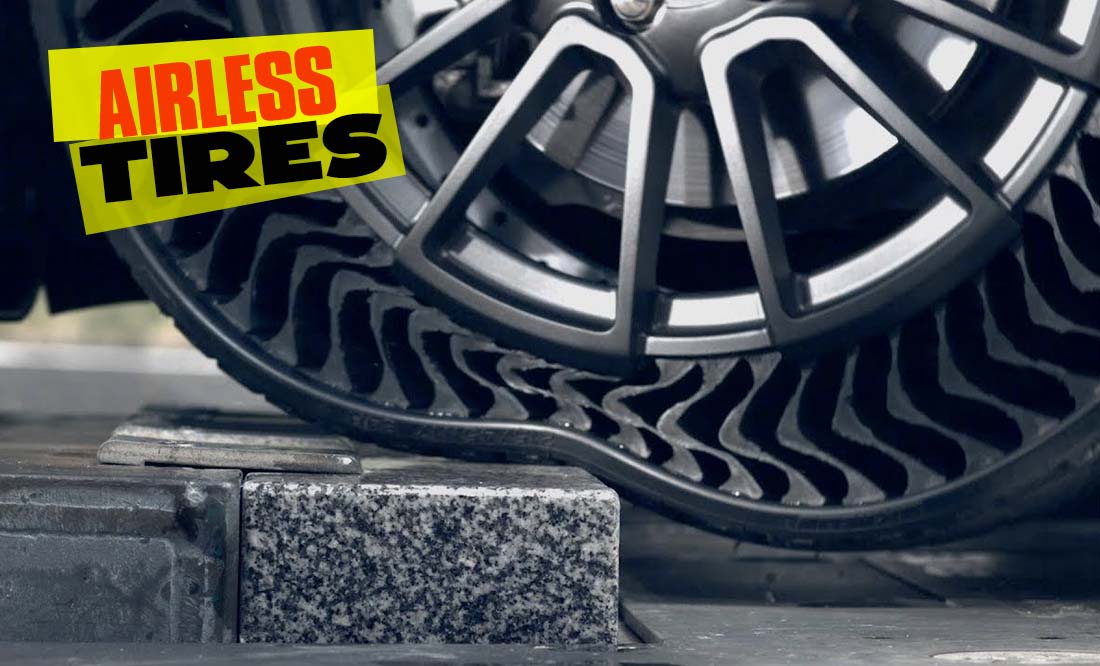As Materials And Designs Improve, Will Non-Pneumatic Tires Finally Emerge?
At first glance, tires — in their very fundamental structure — haven’t really changed all that much in the last 20 years or so. Sure, lots of improvements in performance and reliability, but in the end, you fill them with air.
The airless tire, on the other hand, is a a single-piece wheel and tire assembly design — replacing all the components of a typical radial tire. The “Tweel,” as it’s called, is comprised of a rigid hub, connected to a shear band by means of flexible, deformable polyurethane.
The New Airless Tire Isn’t New
Over the last couple of decades, we’ve read a handful of press releases from various tire companies announcing the coming of the airless (non-pneumatic) tire. (Actually, Goodyear has supplied air-filled tires for more than 100 years for industrial and recreational vehicles, has announced that it is trialing airless tires for an autonomous delivery company and eventually, passenger vehicles). But while we’ve read much, we haven’t seen much. Until, well, maybe very soon. Today, Goodyear, Bridgestone, Firestone, Hankook, Michelin and others are working hard to complete the development and get a rugged, reliable and responsive tire on the road.
The New Airless Tweel Design
The emerging design starts with the outer edge of the tire — with a strong polyurethane band, stretched around an supporting set of polyurethane spokes. The alloy wheel is then nested within this ring, providing a highly supportive wheel without the need for a conventional tire. The Tweel is designed so the spokes absorb all impact — without an inflated tire, the wheel cannot burst or get a puncture. But it’s not without its critics. Reports are that the Tweels are noisy and often excessively vibrate, especially at high speed.
So Here’s The Good News About Airless (Non-Pneumatic) Tires
- You’ll never get a blowout. That means no loss of control and risk of crash as a result
- A puncture in the tweel’s tread won’t cause a “flat”. So you won’t get stranded or stuck changing a tire on the side of the road.
Now Here’s A Bit of Concerning News About Airless (Non-Pneumatic) Tires
- These tweels are heavy — obese, actually. Far heavier than pneumatic tires. As a result, they’re pretty tough on suspension and can wear out components far more quickly on a vehicle designed for pneumatic tires
- The ride? Old-school, pneumatic tires win. Today, air delivers a better ride. Tweel tires don’t handle as responsively or easily and they don’t absorb bumps especially well. Lots of vibration and jolting when the tires hit potholes and bumps in the road
- Tweels require an increased braking distance (reportedly up to 10%) and most notably, these tires lower fuel economy thanks to more rotating mass compared to a typical passenger tire
How Tweels Work
Based on a biomimetic design, engineers may have finally delivered a non-pneumatic tire with a high level of shock absorption and large load-bearing capacity — that reduces tire maintenance costs. A fortuitous byproduct is increased safety due to its airless construction. That’s the plan, we’re not there yet and we’re not sure exactly when we’ll get there, but with the pace of change in the auto industry we’re experiencing, Airless Tweels may appear as early as the next 12-24 months, but’s that’s a wild guess. After all, tire companies have been promising airless, indestructible tires for a while.
Goodyear has done extensive development with their design. They’ve incorporated polyester that was recycled from plastic bottles and other plastic waste. Then reverted into its base chemicals and reformed into a product that is feasible for tire cords, Goodyear said. Current tires use about 30% sustainable materials, with the demonstration tire at 70% more than doubling that percentage.
Chris Helsel, Goodyear senior vice president, global operations and chief technology officer, said in a recent release, “We set an ambitious goal in 2020 to create a tire made 100% from sustainable materials in 10 years, and our scientists and engineers have made great progress toward that goal,”
Goodyear also said it is testing a custom-engineered non-pneumatic, or airless, tire for Starship delivery robots on the Bowling Green State University campus.







![[Presentation] Livestream of TMC’s Press Conference](https://www.miamicars.com/wp-content/uploads/2023/02/tmb_corporate-218x150.png)





![– [ ] ☎️CALL NOW!! ????????
– [ ] (786)650-9456 #ydiaztowing
– [ ] ????Best Towing Service in Miami????
– [ ] .
– [ ] .
– [ ] .
…](https://www.miamicars.com/wp-content/uploads/2024/07/452023016_17885815152082011_6665345158017245266_n-100x70.jpg)



![– [ ] ☎️CALL NOW!! ????????
– [ ] (786)650-9456 #ydiaztowing
– [ ] ????Best Towing Service in Miami????
– [ ] .
– [ ] .
– [ ] .
…](https://www.miamicars.com/wp-content/uploads/2024/07/452023016_17885815152082011_6665345158017245266_n-324x160.jpg)
